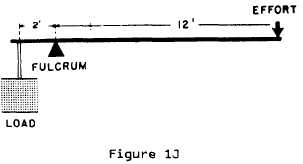1-30.
The rope in a block and tackle is
called a
1–26.
The mechanical advantage of the
lever pictured in figure 1J is
1.
five
2.
six
3.
seven
4.
one–sixth
1–27.
The combination dog and wedge of
textbook figure 1-10 is a complex
machine since it consists of which
two simple machines?
1.
Lever and the screw
2.
Two first–class levers
3.
Lever and the inclined plane
4.
One first-class lever and one
second-class lever
Information for questions 1-28 and
$
1-29:
The handle of a hatch dog is
9 inches long.
The short arm is 3 inches
long.
1-28.
What is the mechanical advantage of
the hatch dog?
1.
12
2.
27
3.
3
4.
9
1–29.
With how much force must you push
down on the handle to exert 210
pounds force on the end of the
short arm?
1.
105 lb
2.
80 lb
3.
70 lb
4.
25 lb
1.
runner
2.
line
3.
fall
4.
sheave
1-31.
The theoretical mechanical
advantage of the single sheave
block of textbook figure 2-2 is
1.
one
2.
two
3.
one-half
4.
zero
1-32.
A single block-and-fall rigged as a
runner has a theoretical mechanical
advantage of
1.
one
2.
two
3.
one–half
4.
four
1-33.
In a block and tackle having a
mechanical advantage greater than
one, how does the distance the load
moves compare with the length of
the rope which is pulled through
the block?
1.
It is less
2.
It is the same
3.
It is greater
4.
It depends on the weight of the
load
1-34.
What advantage can you obtain by
replacing the single fixed block of
textbook figure 2-3 with the gun
tackle purchase of textbook figure
2-6?
1.
You can pull the rope from a
more convenient position
2.
You need to exert about 1/3 as
much effort to lift the same
load
3.
You can lift the same load in
1/2 the time
4.
You need to exert about 1/2 as
much effort to lift the same
load
5

